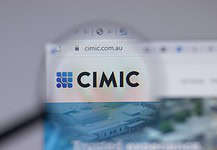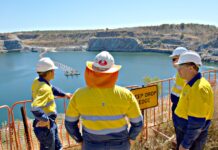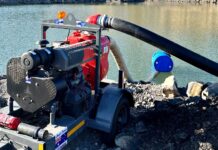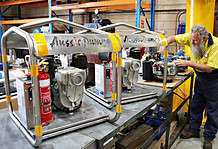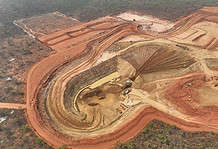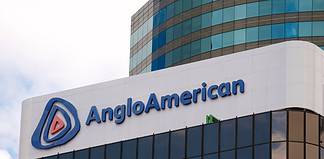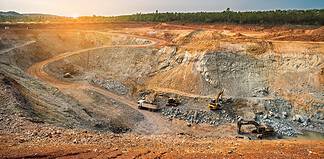Mining at Kinsevere in the Democratic Republic of Congo.
By Cameron Drummond
AFTER the record breaking purchase of the Las Bambas copper project in Peru, MMG has had a reasonably quiet 18 months consolidating and improving existing projects.
MMG Limited is a Chinese-owned (China Minmetals 74 per cent) mining consortium listed on the Hong Kong Stock Exchange and ASX with copper, zinc and other base metal projects across four continents.
MMG aims to become one of the top mid-tier miners by 2020 by investing in significant exploration and development projects such as the Las Bambas copper operation in Peru, aquired from Swiss-based miner Glencore for $US5.85 billion in 2014.
The company also owns the Sepon and Kinsevere copper mines in Southern Laos and the rolex datejust m126234 0046 36mm herren uhr Democratic Republic of the Congo (DRC), respectively, and the Century, Golden Grove and Rosebery base metal operations in Australia.
Additionally, MMG has zinc exploration licenses at Dugald River in QLD and at the Izok Corridor project in northern Canada.
Its Australian, Laotian and Canadian projects were acquired in 2009 when China Minmetals paid $2.6 billion for all of OZ Minerals’ assets, excluding Prominent Hill.
Las Bambas
The Las Bambas joint venture, a long-life open pit copper mine in the Apurimac region of Peru, was bought from Glencore in 2014 for $US5.85 billion.
It is owned and operated between MMG (62.5 per cent), Guixon International Investment (22.5 per cent) and CITIC Metal (15 per cent).
The mine produced its first copper concentrate in December 2015 and completed construction in the first quarter of 2016, progressively ramping up to commercial production by 1 July.
It is MMG’s main copper producer with 106,123 tonnes of copper concentrate during the September quarter, up 22 per cent from the previous quarter.
Once in full production, MMG stated that Las Bambas would be one of the world’s largest copper mines, with an annual nameplate throughput capacity of 51.1 million tonnes (mt) and an estimated mine life of more than 20 years.
Production for the first nine months of the year totalled 224,736t of copper concentrate, just shy of its yearly guidance range of between 250,000t and 300,000t.
There was however no change to its 2016 guidance as it cited ongoing risks associated with its continued ramp up of the processing plant at the mine.
On 21 July, all concentrate trucking at Las Bambas was temporarily suspended after a local community member died on the road. MMG then implemented additional measures to improve transport safety, which subsequently allowed the mine to increase back to full capacity by mid-September.
Transport disruptions again overshadowed operations at Las Bambas in October following 10 days of regional unrest in the communities along the transport corridor near the mine.
On 24 October MMG relayed that the Government of Peru and local communities had agreed a framework for future dialogue and cooperation in the region.
“The process of restoring calm in local communities and the re-opening of essential infrastructure is now underway,” MMG said in a statement.
“The company expects that key road transport logistics will be restored progressively via an alternate route and people and supplies have begun to again move freely on local roads.
It was anticipated that backlogs of about 100,000t of copper concentrate due to the transport disruptions would be sold down in the first quarter of 2017.
MMG maintained a C1 cost guidance within the range of $US1.00 and $US1.10 per pound (lb) for the second half 2016, and between $US0.80 and $US0.90/lb once the plant was at a steady state in future.
Kinsevere
Kinsevere production for the nine months to 30 September 2016 was 59,843t of copper cathode, in line with the previous corresponding period, as the operation continued to produce above its nameplate output.
About 62,200t of ore from the nearby Kalumines deposit, acquired through an offtake agreement, was milled in the third quarter.
Power supply initiatives continued to be implemented at Kinsevere to improve the availability of reliable grid supply.
During the September quarter 85 per cent of power requirements were sourced from grid power providers and the remainder from site based diesel power generation.
Guidance at Kinsevere remained unchanged at between 75,000t and 80,000t of copper cathode in 2016 at a C1 cost of between $US1.40 and $1.55/lb.
Australia
Production and cost guidance at both Golden Grove and Rosebery operations remained unchanged for 2016.
Golden Grove, 250km east of Geraldton, WA, was on track to produce within its yearly guidance range of between 45,000t and 55,000t of zinc and between 10,000t and 12,000t of copper.
It expected C1 costs of between $US0.30 and $US0.45/lb for zinc, and between $US1.90 and $US2.10/lb for copper in 2016.
Exploration drilling at Golden Grove had continued during the year at the Xantho targets, and was anticipated to conclude in early 2017.
Operating since 1936, MMG’s Rosebery is an underground base metal mine near its namesake township in northern Tasmania, which produced 92,104t of zinc and 21,312t of lead in 2015.
Due to depletion, it was on track to produce a lower guidance of between 75,000t and 80,000t of zinc at a C1 cost of between $US0.30 and $0.40/lb and between 18,000t and 22,000t of lead for 2016.
During its 16 years of operation, MMG’s Century mine in North West QLD produced and processed zinc and lead concentrates and was still on care and maintenance as mine closure activities continued.
Sepon
Commencing production in 2005, Sepon is an open-pit copper mine in Savannakhet Province, southern Laos, of which MMG owns 90 per cent and the Lao Government 10 per cent.
Copper mined from the high-grade Khanong ore body was increasingly being supplemented by expansion into the western area pits, including the Thengkham and Phabing deposits.
Copper cathode production at the mine was down 19 per cent compared to the first nine months of 2015, as the transition to lower grade and more complex ores continued.
In 2015 Sepon produced 89,253t of copper cathode; MMG remained on track to produce within its guidance of between 80,000t and 85,000t at a C1 cost of between US$1.10 and $US1.25/lb.
Exploration & Development
According to MMG, the Dugald River zinc project was 28 per cent complete, and on target for first concentrate production in the first half of 2018.
So far the permanent village expansion to 400 persons was completed and operational, 75 per cent of processing equipment had been delivered to site, high voltage transmission line pole installation had commenced, and the tailings storage facility embankment construction was 80 per cent complete.
MMG stated it had further improved project value by reducing project capital cost and ongoing mining unit cost; enabling increased production and improved mill utilisation; and increasing productivity through better mine and operations planning.
The expected remaining cost of the project from July 2015 to first shipment of concentrate was reduced by up to $US150 million – from $US750m to $US600m, plus interest costs.
As a result, the optimised mine plan would support a 1.7mtpa operation with an annual production of around 170,000t of zinc in concentrate, plus by-products.
The mine would be able to operate for an estimated 25 years while the ore body remains open at depth.
Key milestones during the 2016 third quarter were 1483m of lateral development, 30,623m of diamond drilling and 199m of vertical shaft development completed.
At its current stage, MMG said Dugald River expected to achieve C1 costs of between US$0.68 and $US0.78/lb when at a steady state of operation.
MMG’s Izok Corridor project near Nunavut, northern Canada, involves two deposits – Izok and High Lake, with mineral resources of 5mt at 13 per cent zinc and 2.3 per cent copper and 14mt at 3.8 per cent zinc and 2.5 per cent copper, respectively.
Mine development still required the construction of a 325km all-weather road and a deep water port on the Arctic Ocean to facilitate the transport of metal concentrates to market.
The company said it was pursuing partnerships with other stakeholders to share the development costs of the project.
Guidance
MMG copper ore reserves increased 6 per cent year-on-year by the end of June, while copper ore output fell 1 per cent year-on-year.
Overall ore reserves had increased due to the increase at Las Bambas, along with additions at Kinsevere.
Copper rose by 6 per cent across all operations, silver by 2 per cent and molybdenum by 7 per cent zinc decreased by 10 per cent, lead by 11 per cent and gold by 5 per cent.
The Las Bambas mineral resources addition partially offset MMG output reductions which were mostly due to depletion, cut-off grade changes and drilling results at MMG’s Century, Golden Grove and Rosebery operations.
2016 guidance was maintained in its quarterly report and MMG expected it would produce between 415,000t and 477,000t of copper and between 120,000t and 135,000t of zinc.
Revenue was down $US527.7m (47 per cent) on 2015 to $US586.1m due to lower zinc sales volumes as a result of the Century mine closure, lower copper production at Sepon and lower average realised prices for all commodities except gold.



